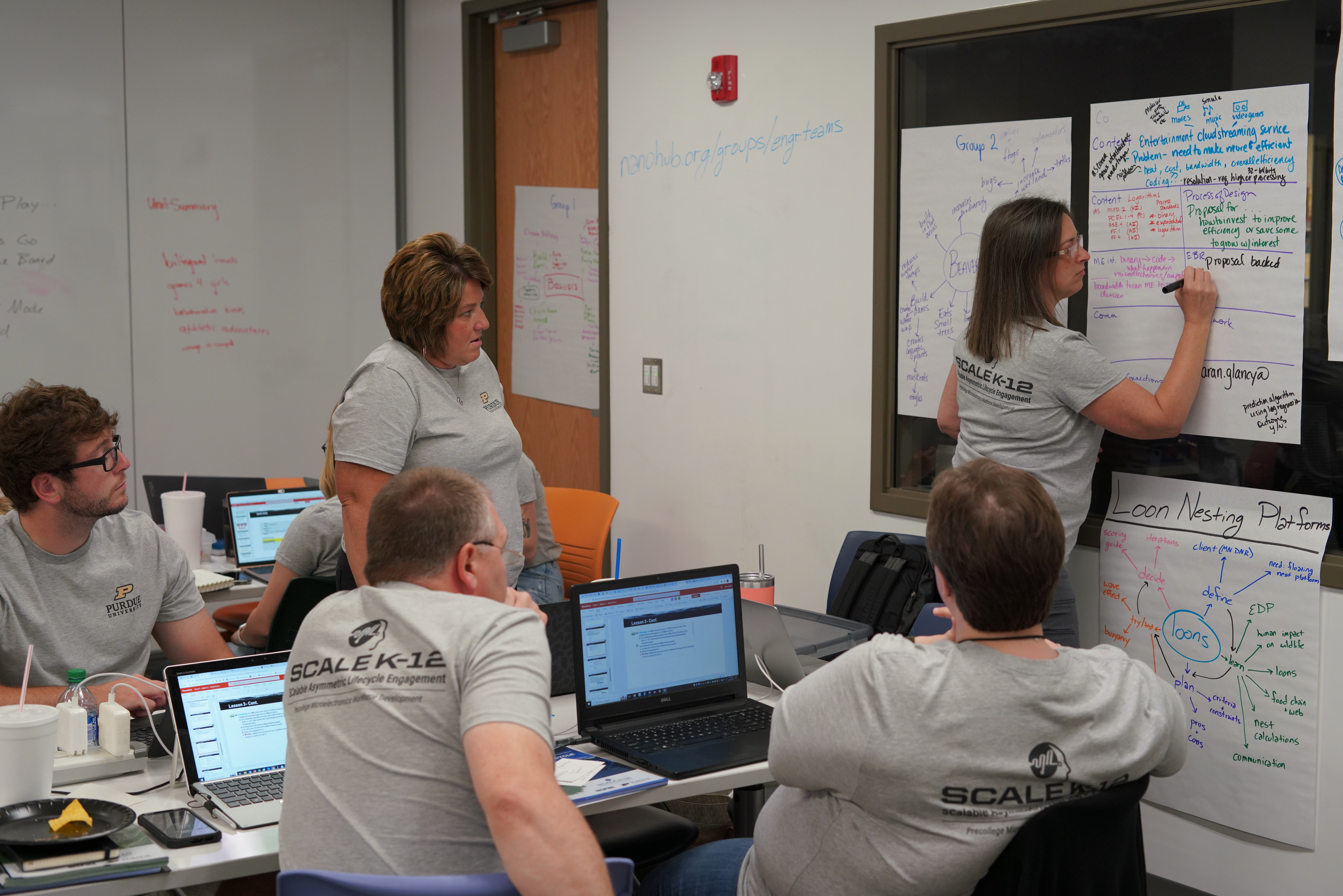Purdue, DOD collaboration to embed microelectronics learning in Indiana classrooms expands to adjacent states
| Author: | Jeanine Shannon |
|---|
Select schools from Illinois and Michigan will join a growing number of Indiana school districts participating in a Purdue University-led program to embed microelectronics content in K-12 classrooms as part of a U.S. Department of Defense (DoD) strategy to build a domestic semiconductor industry.

Led by faculty from Purdue University’s School of Engineering Education, the SCalable Asymmetric Lifecycle Engagement in K-12 (SCALE K-12) program was awarded $2.5M from the Silicon Crossroads Microelectronics Commons Hub (SCMC) in January 2024 to expand its reach to 19,000 students in 12 school districts across the three states. With this expansion, SCALE K-12 will bring aboard another Indiana school district near the DoD’s Naval Surface Warfare Center-Crane and Purdue’s Westgate, which houses several microelectronics industries in Crane, Ind., as well as partner with K-12 technical education capabilities in one district in Illinois and another in Michigan.
All three states participate in the SCMC Hub coalition led by the Microelectronics Commons-funded Applied Research Institute (ARI), which received millions in federal dollars last September from the CHIPS and Science Acta $52B appropriation in total to boost domestic semiconductor manufacturing and research.
SCALE K-12 was launched in 2022 by Purdue ENE’s INSPIRE Research Institute for Pre-College Engineering with the aim of helping schools located near the microelectronics industrial base in Indiana to integrate microelectronics across the curriculum in order to help seed the future workforce. At that time, SCALE K-12 was awarded “$3M in DoD funding from the Trusted & Assured Microelectronics (T&AM) Program with a $3M matching grant from the Indiana Economic Development Corporation, with support from Purdue’s SCALE semiconductor workforce development program. Led by Purdue University, funded by the Department of Defense, and managed by NSWC Crane, SCALE facilitates a different approach to training highly skilled U.S. microelectronics engineers, hardware designers, and manufacturing experts, ensuring U.S. leadership in this important area.
The SCALE K-12 initiative partners with approximately 40 teachers per year in-person to develop curricular modules and activities focused on microelectronics contexts and/or concepts. Middle school geometry teachers, for example, may use the idea of how to manufacture microchips to teach the concepts of area and volume. The teachers then pilot the curricula in their K-12 classrooms as part of a curriculum improvement cycle. Teachers and researchers together then develop modules for online learning for other teachers to learn about the curriculum. The SCALE K-12 team conducts research to assess the impact of using engineering design as pedagogy to integrate microelectronics. Teachers receive funding for participation and the classroom materials needed to implement curricular units.
“This project requires a big commitment from K-12 educators because we ask them not only to help us design learning modules, but to work with their administrators to think beyond single classrooms and to vertically align microelectronics learning throughout grade levels,” said Tamara Moore, Ph.D., a Purdue Professor of Engineering Education who co-directs INSPIRE and directs SCALE K-12. “Vertical alignment involves introducing microelectronics early to help children understand all the ways that microchips play a part in our daily lives, from smart devices to anything with a digital component.”
Teachers are selected for this professional development opportunity by their school districts. Through summer professional development and curriculum-writing workshops paired with individual coaching, SCALE K-12 Fellows develop modules and activities that meet the academic standards of their respective states, and each module/activity goes through an extensive design research cycle to ensure its quality before publication on the nanoHUB online digital platform.
In addition to the two new Indiana school district participants, SCALE K-12 has partnered with multiple school districts in Indiana including Benton Community School Corp., Greater Jasper Consolidated Schools, Lafayette School Corp., Loogootee Community Schools, Purdue Polytechnic High Schools, the Tippecanoe School Corp., Washington Catholic Schools, and Washington Community Schools. Participating districts in Illinois and Michigan have not yet been announced.
Purdue ENE’s SCALE K-12 collaborators include the Purdue College of Education’s (CoE) Department of Curriculum and Instruction; Purdue Polytechnic Institute; the Indiana University Department of Instructional Systems Technology, the Regional Opportunities Initiative, the University of Illinois, and a university in Michigan to be named later. Moore and Purdue Polytechnic Associate Professor of Technology Leadership & Innovation Greg Strimel serve as the project’s director and deputy director, respectively, along with additional co-PI’s Morgan Hynes and Kerrie Douglas, who are ENE associate professors, and CoE Professor of Science Education S. Selcen Guzey. Indiana University Professor Anne Leftwich, University of Illinois Teaching Assistant Professor Molly Goldstein (a Ph.D. graduate of ENE), and Michigan State University Professor Aman Yadav round out the collaboration.

